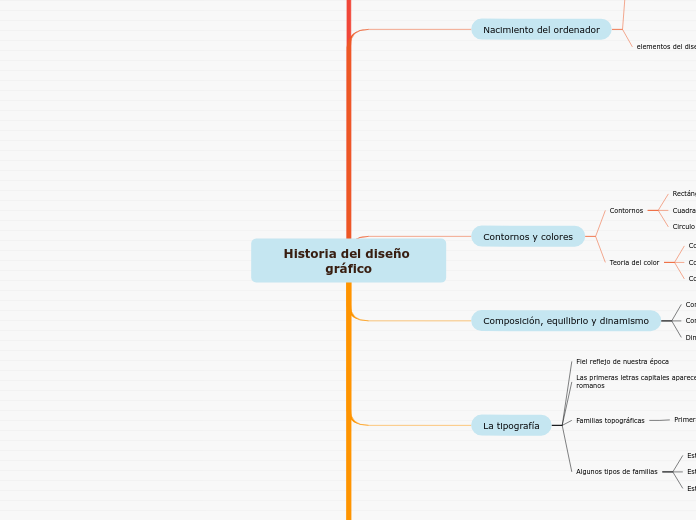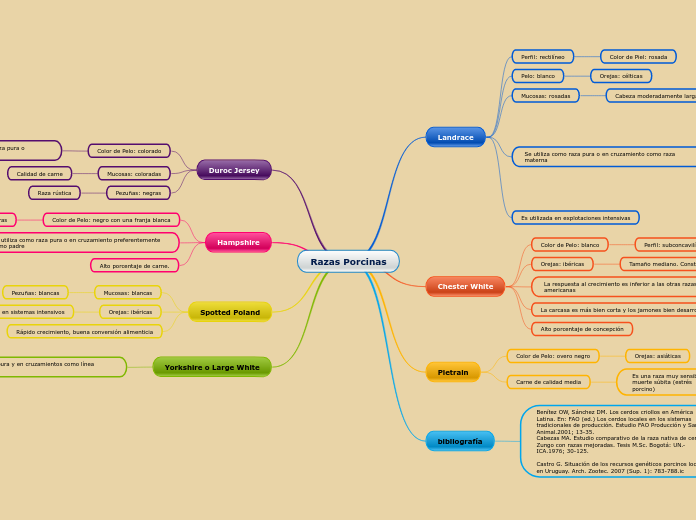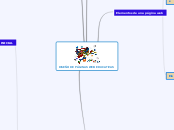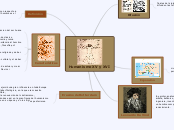Historia del diseño gráfico
To name your story, you have to think about the overall message and what you want your audience to understand from the story. Also, make it relevant and easy to remember.
Elementos de ordenación
Gestor de contenidos
Guia de estilos
Maqueta o prototipo
Mapa de sitio web o navegación
Componentes de una interfaz web
Espacio de blanco
Pie de página
Cuerpo de página
Sistemas de navegación
Cabecera
Diseño en las páginas web
Planteamiento de relación de un sitio web
Área técnica
Área artistica
Área de producción
Área de redacción
Diseño de comunicación digital
Soporte Ofnline
Soporte Online
Soporte digital
La tipografía
Algunos tipos de familias
Estilo moderno
Estilo antiguo
Estilo clásica
Familias topográficas
Primera clasificación
La forma del grosor
La forma del serif
La presencia o ausencia de serif
Las primeras letras capitales aparecen con los romanos
Fiel reflejo de nuestra época
Composición, equilibrio y dinamismo
Dinamismo
Atraer la atención
Composición de texto
Facilitar la comprensión del texto
Composición equilibrada
El espectador busca una visión equilibrada
Contornos y colores
The ending of a story is essential. We all know that if the ending is weak, what happened before loses its importance. So make it unpredictable, but fair. A resolved ending answers all the questions and ties up any loose threads from the plot.
Teoria del color
This is the closure section of the story.
See examples of possible outcomes below:
- all problems have been solved
- it's clear how each one of your characters ends up
- your main character is transformed by the challenge
Colores terciarios
Try answering these questions in order for you to come up with a closure:
- Have all problems been solved?
- Is it clear what happens with all your characters in the story?
- Has the challenged transformed your main character?
- How do the characters feel in the end?
Colores secundarios
Colores primarios
Try answering these questions to come up with a closure:
- Have all the problems been solved?
- Is there a clear picture of what happens with each character in the story?
- Has the challenge transformed your main character?
- How do the characters feel in the end?
Contornos
This is the moment when the main character surpasses the last obstacle and finally faces their greatest challenge.
The climax usually follows one of these patterns:
- realization
- resolution
- choice
Type in your answer.
Circulo
Cuadrado
Rectángulo
Nacimiento del ordenador
The middle of the story is where you add layers of complications that will lead to the end. Reveal more about the character's journey. Did their personality go through changes? How did they overcome the challenges? And as you build up the story’s central conflict, make it more personal to that character. Also, from the middle act, you have to lead into the final act.
elementos del diseño
Your character(s) need(s) motivation in order to solve the challenge(s).
Elementos prácticos
Función
Significado
Representación
Elementos de relación
Secondary characters also might have motivs beacuse of which they may cross path with main character or which might trigger them to help the main character.
Gravedad
Espacio
Posición
Dirección
Elementos visuales
Secondary characters might also have motives that lead them to cross paths with the main character or which might trigger them to help the main character.
Textura
Color
Tamaño
Forma
Elementos conceptuales
Why does your character need to confront this challenge? What does he/she expect to accomplish by solving it?
See a few examples:
- will marry in 3 days
- can fix the mistakes of the past
Volumen
Plano
Linea
Punto
Aparece un nuevo tipo de diseñador
Each story has a main character and that character usually needs to solve a problem or challenge. The character's challenge is the one that creates tension throughout the story.
El diseñador web
In most stories, there are 3 challenges. The number 3 is a mystical number symbolizing completeness. Try to come up with interesting challenges with which your character needs to struggle.
See a few examples below:
- turns into a werewolf at night
- is sent back in time
Informático
diseñador gráfico
Comienzo
In the beginning of the story (or the exposition), you will need to introduce the setting and characters. You might also want to introduce the main conflict. This part of the story is important because it gives the reader necessary background information and maybe even a first insight into a character’s personality.
Año 1440
The setting (time & place) of a story can change throughout the plot.
Comienza el nacimiento de la industria
The time of the story can also change. It can describe the event of a single day or can include an entire year's plot. Anyway, don't forget to mention it.
Empieza aparecer a la vez el diseño gráfico
Nace la publicidad
Gutenberg diseña la imprenta
Your story can take place wherever your imagination will take you to.
For example: in an elevator, in an enchanted forest, etc. Don't forget to give details of the environment each time the setting changes, otherwise, the story can be confusing. Also, mention the seasons as each of them has unique weather and events.
Primer libro que imprime es la biblia
Alemania
La historia comienza a contarse
Characters are essential to a good story. Usually, the protagonist(s) is/are the most affected by the plot. Introduce a character by focusing on their actions, interests, and occupation, as the physical appearance doesn't make a difference in most cases.
con la aparición de la escritura
Type in the name of your character.
En la edad media se puede ver además los primeros estilos de tipo grafía
Add other qualities/attributes of the character.
Los egiptos la usan en jeleogricos
Which traits best describe the character's personality? Choose more if necessary:
introvertedloyalkindindependentquick-thinkingadventuresomeidealisticsweet-naturedcalmrisk-takercreativewittystrictfussyweirdclumsyharshaggressivecarelessclingingcowardlycrueldeceitfulimpulsiveOther
Hay escritura desde el comienzo del hombre en las cuevas
Choose the type of your chacter:
Protagonist (main character)Antagonist (main character's opponent)Flat (stereotypical character)Round (his/ her personality develops throughout the story)Static (doesn't evolve as a person throughout the story)Dynamic (dramatical change in personality)Confidant (the main character trusts him/ her)Foil (contrasting character who enhances the personality of another character)Other










